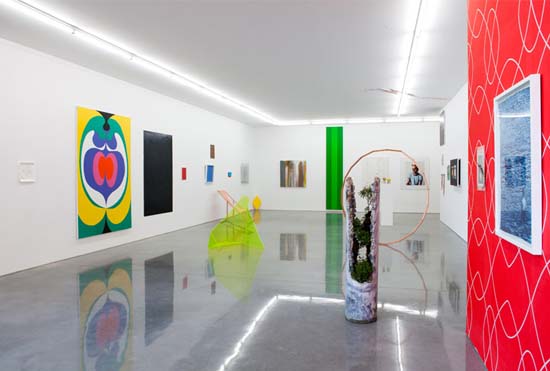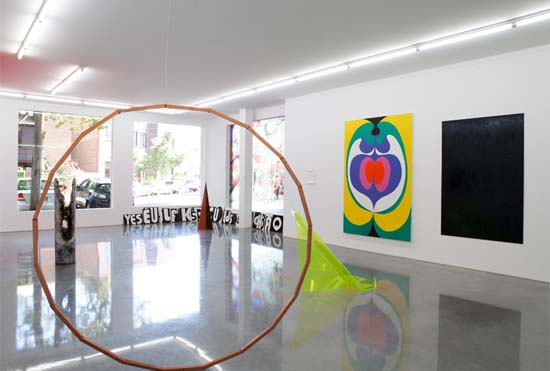From Fiona McIntosh…
20/200, shorthand for 200+ exhibitions over 20 years, was the celebration of twenty years of Sarah Cottier Gallery (SCG) in Sydney.
It was a party to which everyone who has exhibited in any of the SCG four venues was invited. Not all the artists remain part of the Gallery stable, but it seemed that all were keen to participate. It was a festival in 2 parts – an exhibition (now finished) and a catalogue – a mighty encyclopaedic tome, some 430 pages. Together, both presented a complete (probably almost) visual history of the Gallery, with photographs from each exhibition as a double page spread in the catalogue and almost all of the 80+ artists who have shown at the Gallery participating in the exhibition.
Twenty years with the doors open (with only a couple of minor breaks), consistently presenting artworks and artists with a vibrancy and relevance to contemporary practice, is certainly worth celebrating.
While the exhibition was installed in the chronological order in which artists had exhibited at the Gallery, the works presented were not necessarily in the same order. Where artworks from these earlier shows could not be sourced, alternatives from either the same period were lent, given, brought out of the stockroom or a more recent alternative was proffered. Something old, something new, something borrowed ……
Hany Armanious was the first solo exhibition in 1994, followed by Matthys Gerber, John Nixon and then Mikala Dwyer. Looking back, it was an impressive line up to start the gallery. Intellectually and visually challenging, at times disturbing, definitely provocative, it would have been a sophisticated and confident eye that saw a future with these artists and artworks.
The delightfully ironically titled Snake Oil launched the commercial gallery, with Armanious’ first solo exhibition postdating his inclusion in the 1993 Aperto in Venice. Both artist and dealer have proven to be anything but pedalling illusions. As Anna Waldmann puts it, in her testimonial in the catalogue: “ … credibility – that difficult to predict and impossible to orchestrate element – was already there.”
No matter Armanious no longer shows with SCG, he remained an honoured guest and chose to be represented by a more recent work, Black Sun 2013. With the visual reference in the catalogue and the new work on the wall, you can see the practice has remained conceptually consistent.
Part of this history of the gallery is also the history of the community of artists and dealers around town. In a way, the celebration of this history was as much about the people involved and the relationships developed as about the artworks. Dealers came to the party to lend works and artists returned to exhibit. In an industry which is not always known for its camaraderie, it is refreshing to note that there is an underlying solid support and respect for rival colleagues.
Dwyer is now also represented by Roslyn Oxley9 Gallery (though in Sydney via Darren Knight Gallery) but she too, along with artists which played a major role in forging this Gallery’s identity, such Stephen Little and Geoff Kleem (William Wright Artists Projects), Tim Silver and Syd Ball (Sullivan & Strumpf) and Robert Pulie (The Commercial) returned to SCG this year, no doubt also honoured guests, to participate.
But to have such luminaries as Gerber, Nixon, ADS Donaldson, Maria Cruz (whose show opens at SCG next week), Justene Williams, Julie Fragar, Koji Ryui, Huseyn Sami and Christopher Hanrahan as your ongoing constants, affirms a strong personal, intellectual and commercial sensibility.
This exhibition, given the many moving parts, was always going to be chaotic: it was a party after all. The Justene Williams transfer on the entry window sets the tone for the relaxed, celebratory mood. For once, the cool elegance of the Gallery’s installation approach was put to one side, and visual mayhem (if only mild) was accepted.
The exhibition was in the relatively new SCG space, in the fast becoming arts hub of Roylston St Paddington. This is the fourth incarnation of the Gallery, as architecturally stylish and distinctive as the others. The Gallery began in Lennox St in Newtown, then moved to Elizabeth St in Strawberry Hills, then to Nield Ave in Paddington and is now settled in Roylston St. The moves between spaces and neighbourhoods seems to be a deliberate strategy in nurturing the artists’ potentials and that of the Gallery’s.
The physical spaces of the galleries to which artists align themselves surely informs how they approach their next exhibition. Shifting venues ensures complacency does not set in, on either the part of the artist, or the gallerist. Each new SCG venue offered a different adventure and a new opportunity for the protagonists to engage and extend themselves, to work with white rooms, walls, ceilings, floors, windows, doors and facades of differing proportions and feel. Anna Waldmann again, “There was a cool design aesthetic and intellectual concern in all the spaces …. [each] an elegant clean canvas for art….”
This is possibly the link that has brought the artists and this gallerist pair together. In the mass of works that made up the exhibition, it is difficult to define a particular aesthetic of this Gallery. The artworks are diverse, the artists’ conceptual frameworks are not the same, the media and use of materials is individualistic, the relationship to contemporary practices varies. It seems that the thread, or possibly the ambition, is more to support and encourage an intellectual engagement with art, its place in a physical space and the confidence with which this is embraced.
The catalogue is a more accurate record of the past 20 years (published by Formist). Little fanfare or critique, save a few testimonials, and with a focus on images of installed exhibitions, the catalogue is a commendable visual record of the Gallery’s contribution to Australia contemporary art practice. A few black & white images, made grainy via digital tinkering, of working behind the scenes, give a more intimate view of the various spaces. Dusting down those transparencies from last century to be made fit for digital publication would have been a project in itself.
Milestones are worth acknowledging. They take on a greater meaning and depth when celebrated in a style which befits the moment. Sometimes a cake and glass of sparkling is not enough to ensure the recognition of what has passed and what is yet to come. Even if they had organised their own party – most of us do – 20/ 200 as an exhibition and catalogue, affirms a place in history for SCG as having played a major role in nurturing many of Australia’s leading mid-career artists.




A great read – enjoyed the guest blogger!